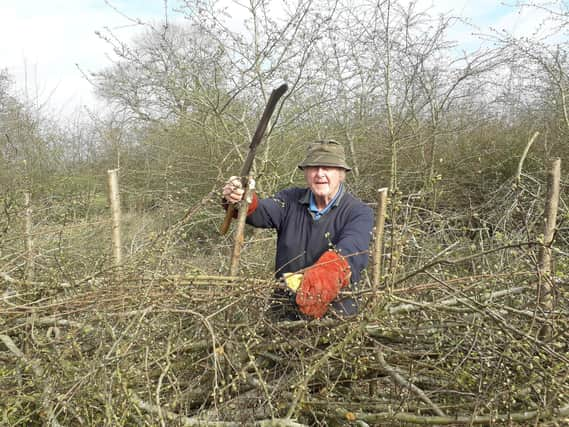'One of the joys of lockdown...talking to ‘Ken the hedge' in Northamptonshire


Lockdown for many has meant discovering or trying a new hobby or interest but for me, one of the joys and indeed privileges of lockdown has meant, (whilst out on long country walks) being able to pause and watch the skill and artistry of a very modest hedgelayer working in the Northamptonshire countryside.
Ken affectionately became known to me as ‘Ken the hedge’ and it appears he has other nicknames too - ‘the stickman’ being yet another term of endearment!
Advertisement
Hide AdAdvertisement
Hide AdI first met Ken when I was out walking a few years ago. I couldn’t actually see him as he was out-of-sight in a ditch, tucked away behind huge piles of shrubs and branches that he’d cleared but I could hear his chainsaw going from some distance away.
I stopped to marvel at the intricate work he seemed to be crafting right in front of my very eyes as he worked his way methodically along the unruly hedge-line. He stopped work when he heard me shout over to him to ask, what was to be the first of countless questions. His trusty billhook was grasped in his gloved hand; the blade of which glinted in the sun.
Born in a village in Somerset, Ken Rogers moved to Northamptonshire with his family aged 12 to Kilsby. He continues to hedgelay some 46 years later having started in 1975. He was totally self-taught, learning his craft by observing other hedgelayers, one in particular he recalls was an “old boy from Crick”, (now long passed) whom he happened to come across whilst working on farms.
The tools of his trade have not changed much, Ken uses a chainsaw but also uses the more traditional axe and of course the fundamental billhook to implement the ‘pleaching’ or partial cutting and bending of the young saplings. Working in the ‘Midland’ style, (there are many traditional styles and techniques in hedgelaying, all very distinct, which define which county or part of the country you are in).
Advertisement
Hide AdAdvertisement
Hide AdThe binders weave in and out of the vertical stakes and form the top of the laid hedge. They look beautiful if you stand at one end and look along the completed section. Ken sets a daily target of about 20 metres a day, which is no mean feat as the amount of vegetation, matted dogwood and branches he has to clear first looks like a wild, spiky caterpillar of bonfires waiting to be lit asides of the neat, completed row.
What he is actually able to complete is down to the weather conditions and the types of material that comprises the hedge itself; some of which is troublesome to separate and tough to clear. Ken is right handed so the hedge to my eyes, (being a left hander) goes in the opposite direction to what I would lay! He informs me that,
“Where possible you should always lay the hedge uphill as the sap runs up.”
This of course is not always possible! His knowledge is fascinating but only invites me to ask more questions!
Advertisement
Hide AdAdvertisement
Hide AdHedgelaying can only be carried out during mid-October to the end of March as this is when trees and shrubs are dormant and any birds that may have found a home in the trees will have finished nesting.
The craft of this ancient countryside skill was even noted and described by Julius Ceasar in his ‘Commentaries on the Gallic War.’ He wrote of his army being “inconvenienced” by thick woven hedges in Belgium.
Ken mentions that sadly, although there is an interest and appreciation in the ancient craft and skills required to lay a hedge, even if younger people try it, after the initial enthusiasm has waned, they soon realise just how physically demanding it is and don’t stay the course.
I for one, marvel at this precious skill; concerned that it might one day disappear in favour of the brutal jaws of the mechanical hedgecutter. The practical purpose of hedgelaying speaks for itself but add in the additional benefits of preservation and conservation and the advantages are manifold.
What treasures indeed lay in our Northamptonshire hedges! Thanks Ken!